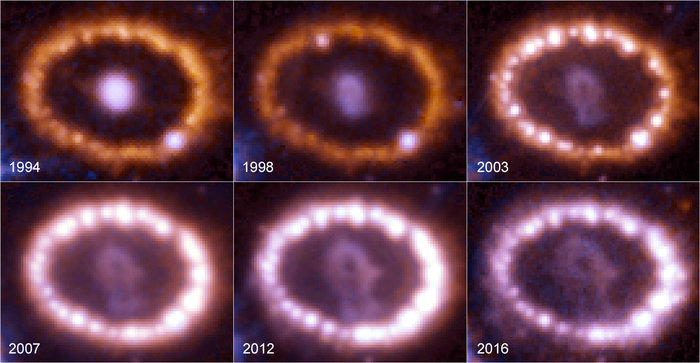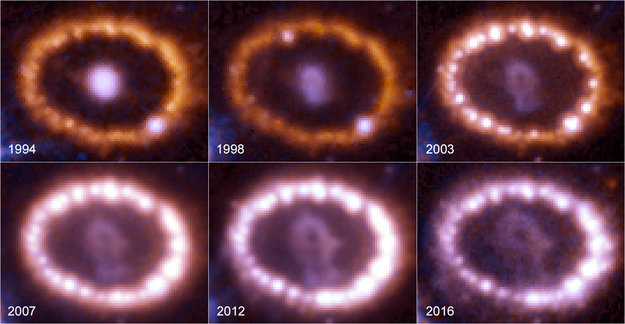http://www.esa.int/esl/ESA_in_your_country/Spain/En_el_final_de_una_supernova

- Title The evolution of SN 1987A
- Released 27/02/2017 9:00 am
- Copyright NASA, ESA and R. Kirshner (Harvard-Smithsonian Center for Astrophysics and Gordon and Betty Moore Foundation) and P. Challis (Harvard-Smithsonian Center for Astrophysics)
- DescriptionThirty years ago, on 23 February 1987, the light from a stellar explosion marking the death of a massive star arrived at Earth to shine in Southern Hemisphere skies.Located in the Large Magellanic Cloud, a satellite galaxy of the Milky Way, SN 1987A was the closest observed supernova to Earth since the invention of the telescope. Studying it for the last 30 years has revolutionised our understanding of the explosive death of massive stars.In operation since 1990, the NASA/ESA Hubble Space Telescope has observed the supernova remnant many times, as highlighted in this montage. The images show its evolution between 1994 and 2016, and highlight the main ring that blazes around the exploded star.A new wide-field image was also taken by Hubble in January 2017 to mark the 30 year anniversary.By observing the expanding remnant material over the years, Hubble has helped to show that the material within the ring was likely ejected 20 000 years before the actual explosion took place.The initial burst of light from the supernova initially illuminated the rings. They slowly faded over the first decade after the explosion, until a fast-moving shell of gas ejected during the supernova slammed into the central ring, sending a powerful shockwave through the gas, heating it to searing temperatures and generating strong X-ray emission.This caused clumps of denser gas within the ring to light up like a string of pearls, seen as the increasing number of bright spots, which are now fading again.As the shock wave continues to move through the shells ejected by the dying star in its final throes of life, who knows what new details will be revealed?
- Id 373834
VERSIÓN EN ESPAÑOL :
En el final de una supernova
27 febrero 2017
El 23 de febrero de 1987, los cielos del hemisferio sur de la Tierra se iluminaron con la luz de una explosión estelar, que marcaba la muerte de una estrella masiva.
Situada en la Gran Nube de Magallanes, una galaxia satélite de la Vía Láctea, SN 1987A es la supernova más cercana a la Tierra observada desde la invención del telescopio. Su estudio a lo largo de estos últimos 30 años ha revolucionado nuestra comprensión de la muerte de estas estrellas masivas.
Como puede apreciarse en este montaje, el telescopio espacial Hubble de la NASA/ESA, en funcionamiento desde 1990, ha observado los restos de la supernova en numerosas ocasiones. Las imágenes muestran su evolución entre 1994 y 2016, destacando el anillo principal que brilla alrededor del remanente. a vuelo
Además, en enero de 2017, Hubble tomó una nueva imagen de gran angular para celebrar su 30.º aniversario.
Al observar la expansión de los restos de esta supernova a lo largo de estos años, Hubble ha contribuido a mostrar que el material del interior del anillo probablemente se expulsara 20.000 años antes de que se produjera la explosión.
La emisión inicial de luz desde la supernova fue lo que en principio iluminó los anillos, atenuándose a lo largo de la primera década tras la explosión, hasta que una veloz nube de gas proyectada durante la supernova chocó con el anillo central, enviando una potente onda a través del gas que lo calentó a altísimas temperaturas y generó una fuerte emisión de rayos X.
Esto provocó que los cúmulos de gas más denso en el interior del anillo se fueran iluminando como una cadena de perlas, algo apreciable en el número creciente de puntos brillantes que, ahora, se están volviendo a apagar.
¿Quién sabe qué nuevos detalles descubriremos a medida que la onda de choque siga atravesando las capas eyectadas por esta estrella en las postrimerías de su vida?
ESA
Guillermo Gonzalo Sánchez Achutegui


No hay comentarios:
Publicar un comentario